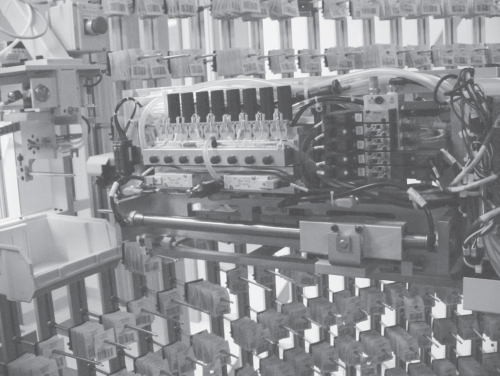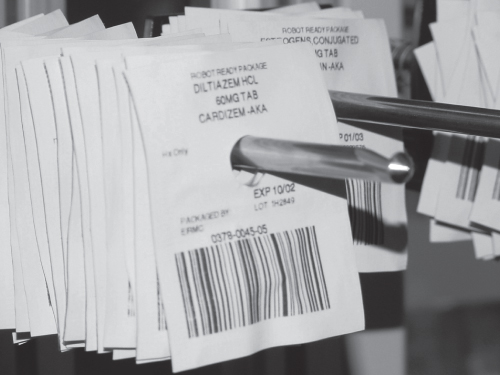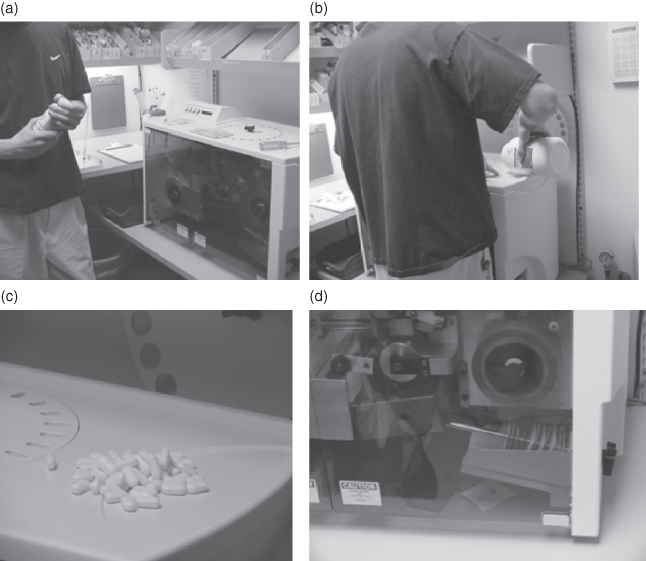22.1 Case Study 1: Overview
Pharmacy robot (PR) is owned by a pharmaceutical company and is leased by the local hospital. This is the only pharmacy in the state to implement the robotic technology in their everyday care of patients. The technology includes the physician writing the drug order in triplicate and the pharmacist reads, interprets, and enters the drug order into the software program that the PR reads. PR uses infrared lights to read the bar code of each drug and fills the patient's drugs for a 24-h period. PR fills 112,000–115,000 prescription orders per month. The robots error rating for picking and filling is zero; however, at the hospital, there are 15–20 documented miss picks per month. These errors are found to be human error in packaging processes and are corrected when the pharmacist makes his check. Some errors occur by the nurse dispensing the wrong drug to the wrong patient; these errors are few and will hopefully be eliminated when the nurse servers are installed later this year. Records indicate that before using PR, error rates for dispensing and distributing drugs were much higher.
22.1.1 Introduction
Our risk assessment class at the University of Idaho performed an analysis of PR, the robotic prescription delivery system and the soon to be used nurse servers, all in service at our local hospital. Figures 22.1 and 22.2 show the components of the robot. PR is a complex system that fills an area of about 600 ft2. Figure 22.3 shows typical, unitized doses of medication on the pick rack. According to the Institute of Medicine Report issued in 1999, upwards of 98,000 Americans die each year from avoidable medical errors, which is the eighth leading cause of death in the United States (1). Almost everyone knows someone (or has at least read about someone), who received the wrong medication as a patient in a health care facility. The human element is the leading cause in drug errors: both miss picks and errors in dispensing medication to patients. Taking into consideration the capabilities and limitations of the human element, mistakes are greatly reduced when we implement design and engineering processes where repetitive manual processes were once used (2). In this chapter, we expound on the abilities, process, and technology that PR has brought into the health care facility, from the pharmacy to the patients' room.
Figure 22.1 Robot arm and unitized doses of medications.

Figure 22.2 Station where robot arm drops unitized doses in bag for delivery to patients.

Figure 22.3 Unitized doses of medication on the pick rack.

22.1.2 Approach
Our class made a field trip to our local health care facility pharmacy where the robot and software system have been successfully implemented. The following describes what we saw as we watched the robot do its job, where errors would most likely occur, and how technology has decreased the possibility of errors occurring.
The robot and acudose cabinets were implemented in 2000. An immediate reduction in mispick errors by the pharmacy in the floor cart fills process occurred. The pharmacy dispenses 112,000–115,000 drugs to patients every month. Historical data show that in the third quarter of the year 2000, there were reported 1424 errors. In the fourth quarter of 2000 (the PR was installed and tested during this quarter), errors were reduced to 568. During the first quarter of 2001, the robot was in full use and errors dropped to 79. By the third quarter of 2001 (1-year after initial implementation), errors dropped to 15, and in the first quarter of 2002, the errors were down to 6. It was determined that the error rate for the robot was very low. The few mistakes that are still happening are because of the human element.
The following events describe how the systems work:
Note: Both packaging machines put a label (the name of the drug and the strength), the National Drug Code (NDC) number, and the bar code that the robot reads.
Figure 22.4 Unitized dose packaging. (a) Step 1: drug is selected. (b) Step 2: pills are poured onto packaging machine. (c) Step 3: pills are loaded into hopper. (d) Step 4: pills are packaged.

From the above sequence of events, it can be determined that still the steps involving the human element are where error would most likely occur. These steps include step 3 (the unit dose packaging room), step 14 (technician moves labeled envelopes from pharmacy cart to floor cart), and step 15 (nurse takes drug from floor cart and gives to patient).
The unit dose packaging room is the first place where an error could occur that would start a chain of events. The technician uses the right bar code, but has the wrong drug or he uses the wrong bar code for the right drug or the pharmacist fails to verify the NDCs on the drug and package/bottle. From here, the wrong drug could pass through the rest of the process and be given to the patient by the nurse. See the fault tree analysis in Figure 22.5.
Figure 22.5 Fault tree analysis.

Steps 14 and 15 are the next opportunities for drug error. In step 14, the technician could be interrupted or not paying attention when moving/delivering/changing drugs from pharmacy cart to floor cart. The pharmacy envelopes could be put into the wrong drawers/envelopes on floor cart. In step 15, the nurse could be interrupted or not paying attention when he/she is dispensing the drugs from the floor cart to the patient. Our analysis shows that the nurse servers would eliminate the errors in step 15.
The Nurse Servers
The nurse servers are cabinets that will be installed outside of each patient room. It will include all the patients' drugs, IV's, chart, lab work results, and anything else pertaining to that particular patient. Everything will be bar-coded. The nurse server system is the implementation of a total bar-code system. As the nurse removes the drugs from the cabinet (nurse server), she will scan her badge to document who is dispensing the drug. She will scan the drug to document which drug is being dispensed. Then she will scan the patient's wristband, which will include a bar code on it. This will document which patient received the drug and what time/date it was dispensed. The pharmacy technician will deliver the drugs to the nurse server cabinets located outside of each patient's room. This will eliminate the chance for error in step 15. The nurse will only have access to one cabinet at one time (one cabinet = one patient), this will eliminate the wrong drug being removed from the floor cart drawer and given to the wrong patient. Presently, on the floor carts, there are 10 drawers to choose from. With the nurse server, there is only one cabinet (drawer) to choose from, thus reducing errors by 10/1. Our observation is that the nurse server is the solution to eliminate the chance of human errors in step 15.
Further Reducing the Potential for Error
Recommendations were generated as a part of our analysis to further reduce the potential for error. The primary one is to create a total bar-code/scan process from the pharmaceutical company to the patient. Have the pharmaceutical company bar code the packages/bottles that are delivered to the pharmacy. Have scanners in the packaging rooms (step 3) and have the pharmacy technician carry a scanner (step 14).
In step 3, have the technician scan his identification badge and the packaged drug from the pharmaceutical company. This will generate the bar code for the drug package that the robot will read (eliminating human element on computer input in the packaging room).
In step 14, have the delivery technician scan his identification badge and the bar-coded envelope, scan the patients' bar code on the nurse server, and scan each drug as he loads them into the nurse server. It is our observation that this would totally eliminate the already low six drug errors in the first quarter of 2002.
22.1.3 Summary
This analysis demonstrated how robotic technology applied in a pharmacy can reduce the potential error significantly. However, errors can still occur. A systematic analysis can point out where these error prone areas are and can help in the formulation of solutions.
